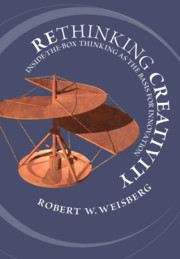Book contents
- Rethinking Creativity
- Rethinking Creativity
- Copyright page
- Dedication
- Contents
- Figures
- Tables
- Part I Introduction
- Part II Analytic Thinking in Creativity
- Part III The Question of Extraordinary Thought Processes in Creativity
- Part IV The Psychometrics of Creativity
- 10 Testing for Creativity
- 11 The Search for the “Creative Personality”
- 12 Two Confluence Theories of Creativity
- Part V The Neuroscience of Creativity
- References
- Index
12 - Two Confluence Theories of Creativity
from Part IV - The Psychometrics of Creativity
Published online by Cambridge University Press: 01 October 2020
- Rethinking Creativity
- Rethinking Creativity
- Copyright page
- Dedication
- Contents
- Figures
- Tables
- Part I Introduction
- Part II Analytic Thinking in Creativity
- Part III The Question of Extraordinary Thought Processes in Creativity
- Part IV The Psychometrics of Creativity
- 10 Testing for Creativity
- 11 The Search for the “Creative Personality”
- 12 Two Confluence Theories of Creativity
- Part V The Neuroscience of Creativity
- References
- Index
Summary
This chapter presents a broader focus on creativity, examining confluence theories of creativity, which propose that the confluence, or coming together, of many factors is critical for creative achievement. Confluence theories go beyond the individual person, examining social and environmental factors that might influence the creative process. The chapter examines Sternberg’s (2018) Triangle theory, which concentrates more on the individual, and Amabile’s componential theory of creativity, which places more emphasis on the role in creativity of factors outside the individual – that is, social factors (Amabile & Pratt, 2016). Amabile has examined creativity and innovation in organizations, including business organizations. The chapter presents the general aspects of each theory, as well as research relevant to it. Points of commonality and difference between the two theories are noted, and a critique of each theory is presented. The basic question being asked in this research is: How far beyond the individual do we have to go to obtain a full understanding of creativity?
Keywords
- Type
- Chapter
- Information
- Rethinking CreativityInside-the-Box Thinking as the Basis for Innovation, pp. 386 - 420Publisher: Cambridge University PressPrint publication year: 2020

